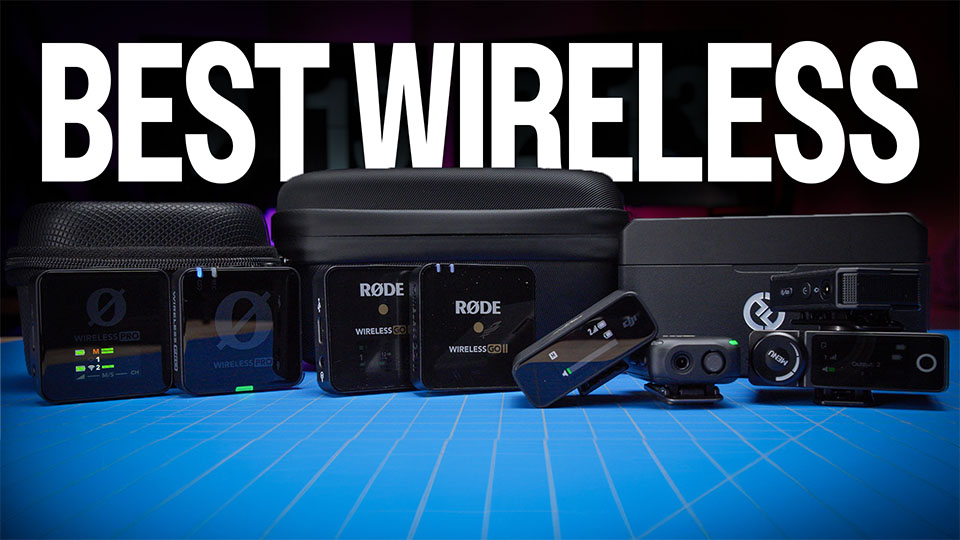Links in this post may be affiliate links. Any products purchased through affiliate links may provide a small commission which helps to support the SemiPro Tech+Gear site and YouTube channel.
In the last few years, wireless microphone kits for content creators have gotten really good. The $300-400 price point now has more competition than ever, which can make it hard to decide which one is right for you. Let’s test four of the top choices and see which one comes out on top.
We’ll be comparing the Rode Wireless Pro, Rode Wireless GO II, Hollyland Lark Max, and the DJI Mic. These kits range from $299 to $399 USD, and represent some of the best wireless mics for content creators in 2023. These are all 2.4GHz wireless mics, so they are susceptible to interference from other 2.4GHz traffic like residential Wi-Fi. Professional UHF systems are going to be a better choice for professional settings where you simply cannot afford any signal issues, but for content creation such as YouTube videos, these kits offer great value for the price…well, except one of them.
Rode Wireless Pro
Top choice for audio quality and feature set.
$399 USD
2 transmitter kit w/charging case
Top Features
✓32-bit internal recording (40hrs)
✓Timecode generation
✓Balanced & rich sound from built-in mics
✓ Great value with everything included
Hollyland Lark Max
A great option at a lower price point.
$299 USD
2 transmitter kit w/charging case
Top Features:
✓24-bit internal recording (14hrs)
✓3 EQ modes and safety track
✓Easy to use receiver menu
✓Most accessories included (except lav mics)
DJI Mic
A touch thinner sound but still a good option.
$329 USD
2 transmitter kit w/charging case
Top Features:
✓24-bit internal recording (14hrs)
✓Compact transmitters (smallest in this group)
✓Safety track and low cut filter
✓ Touch/swipe menu system
Rode Wireless GO II
Least natural-sounding in the group.
$299 USD
2 transmitter kit (no charging case)
Top Features:
✓24-bit internal recording (7hrs)
✓Compatible with Rodecaster & Rode Connect
✓Safety track
Specifications
When it comes to specifications, these kits have many things in common with the exception of the Wireless Pro. All of them utilize the 2.4GHz frequency band, so while they can operate at impressive range, the reliability of the signal is not quite in the “professional” range like a UHF system. So while the Wireless Pro offers some excellent features the other kits do not, like 32-bit float internal recording and timecode generation, it may not be “Pro” enough for professional videographers. All of these wireless microphones, however, offer features very well suited to content creation or even wedding videography.
| Internal Recording | Transmitter Battery Life | Stated Range | Charging Case | Special Features | |
|---|---|---|---|---|---|
| Rode Wireless Pro | 32-bit / 40hrs | 7hrs | 260 meters | Included | Timecode generation, auto-gain |
| Hollyland Lark Max | 24-bit / 14hrs | 7.5hrs | 250 meters | Included | Noise cancellation, 3 EQ Modes |
| DJI Mic | 24-bit / 14hrs | 5.5hrs | 250 meters | Included | Low Cut Filter |
| Rode Wireless GO II | 24-bit / 7hrs | 7hrs | 200 meters | Not Included | None |
Where the Rode kits (even the Wireless Pro) fall short of the Lark Max and DJI Mic is in the receiver menu system. Both the Lark Max and DJI Mic have touch screens and although small, are much more intuitive and easy to navigate than the button system of the Rode receivers. The Wireless Pro screen and menu is a marginal improvement from the GO II, but still has a ways to go in terms of being simple and intuitive. It takes little to no knowledge of the kit to use the menu system on the Lark Max or DJI Mic, while that is not true of either Rode receiver.
The three kits that do include a charging case with the base receiver automatically power on and connect when you remove them from the case. The Wireless GO II has a charging case that can be purchased separately for $79, pushing the total cost to $378 and it still won’t have all the same accessories that come in the other kits. See the Value section below for my conclusions on overall kit value (hint: Wireless GO II is not the winner).
The Wireless Pro adds some features that the others lack, including timecode generation and auto-gain. Both Rode kits have one other feature up their sleeve that the other kits cannot match: connectivity with Rodecaster Pro devices and Rode’s free mixing software (Rode Connect & UNIFY). The transmitters from both the Wireless GO II and Wireless Pro can connect to the Rodecaster Pro 2 and Duo because they have a built-in receiver. This adds an additional audio input channel on both devices, which is great for that surprise guest you weren’t expecting and don’t have a dedicated mic for. You can also connect the receiver via USB to your computer and use the transmitter mics as additional input channels in Rode’s Connect and UNIFY mixing software (both free). So if you’re in the Rode ecosystem already, it may make sense for you to stick with one of Rode’s wireless mic kits to take advantage of those features.
Sound Quality & User Experience
The sound quality of the built-in microphone of the Lark Max is excellent for a wireless kit in the $300 price range. Both the Hi-Fi and Vocal Boost EQ modes provides a rich sound with a full-sounding low end. The Rode Wireless GO II sounds thin and too mid-forward by comparison. The DJI transmitter mic sounds somewhere in-between, with a good sound quality that is not unpleasant and more balanced than the GO II, but not my favorite. The Wireless Pro is the clear winner in terms of sound quality of the built-in mic, and it’s not even close. The Wireless Pro sounds the most balanced, with a full low end and a top end that is not shrill or brittle-sounding. In my testing it handled post-processing the best, meaning I was easily able to get the sound I wanted without a ton of work.
As I mentioned above with regard to the screen menu systems, the user experience of the Lark Max and DJI kits is a step above both Rode systems. The Wireless Pro is a better user experience than the GO II in my opinion, but there are still too many functions that require confusing button-press combinations or are only accessible in Rode Central on a computer to be called “intuitive”. The Lark Max and DJI both made an effort to simply the use of their kits at every step, including the receiver menu systems which don’t make you memorize which buttons to press for certain functions.
Range
As I said in my review of the Hollyland Lark Max, the stated range for 2.4GHz wireless microphones needs to be taken with a grain of salt. The maximum range stated by manufacturers was achieved in an ideal laboratory situation. In my real-world testing, I haven’t been able to consistently get usable results at stated maximum ranges. However that isn’t a big deal in my opinion.
I’ve tested wireless mic kits in two environments: in a densely populated urban area near several apartment buildings and lots of residential Wi-Fi around, and in a suburban field with a few houses but much more wide open space. Across all these kits, I’ve found two things to be consistently true. In the more populated area with a lot of 2.4GHz signals around, none of the kits perform consistently at distances greater than 50-60 meters. At a distance of 50 meters from the camera, even a strong wind has caused signal dropouts for me, with a clear line of sight to the camera.
In the more open suburban field, I get a consistent signal on all of them up to 100 meters. Past 100 meters and again I start to get signal dropouts – not totally unusable, but also not reliable.
This holds true for all four mic kits in my testing. The Wireless Pro and Lark Max did perform beyond 100 meters, but inconsistently. Sometimes even a breeze seemed to break up the signal in the wide open suburban space at distances of 150 and 200 meters. There are two reasons this is not a big deal: first, all these kits offer internal recording, so you will always have good audio to use even if the signal does break up. Second, I think most content creators will be using these mics within a 50 meter range. If you haven’t measured out 50 meters recently, go measure 50 meters from your camera and you’ll understand my position. Especially for solo content creators without a camera operator, it’s not going to be very common to have a need to be that far away from your camera.
Value
In terms of value for the price, again the Wireless GO II is in last place. Compared to the three newer options, it just doesn’t include nearly as much value for the $300 cost. Even if it were discounted to $250, I still wouldn’t think it’s worth it in 2023 because, as I mentioned above, the sound of the built-in mic is the least natural of the group. The Wireless GO II kit does not include a charging case (sold separately for $79), lavalier microphones, magnetic clips, or a USB to lightning adapter. Both the Lark Max and DJI mic kits include all these things for the same or only slightly higher price, in addition to sounding better.
At the $300 price point, the Lark Max and DJI kits both offer good value. They both include a charging case, magnetic clips, and all the cables that you need (including USB to lightning). Neither kit includes lavalier microphones, so that would be the only thing you need if you plan to use one.
The Rode Wireless Pro offers the vest value for the price, even though it’s the most expensive at $399. Not only does it have the most natural and full-sounding built-in mics, it also includes the most features & accessories. In addition to 32-bit float recording, timecode generation, and threads for locking connector lav mics, the kit includes two Rode Lavalier II mics ($99 retail each), a charging case, and all the cables you need.
Conclusion
We’ll keep this brief. My top choice overall is the Rode Wireless Pro. This is an amazing improvement from the Wireless GO II. Rode not only made an exponentially better-sounding wireless mic than their previous one, but they also significantly improved the value-to-price ratio, making it my top recommendation for content creators. In my content creation journey I’ve owned some Rode products that didn’t quite meet my expectations and some that far exceeded them. The Wireless Pro is the latter.


